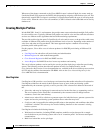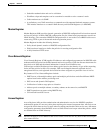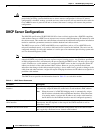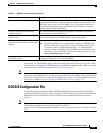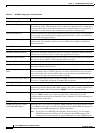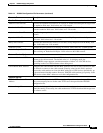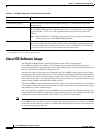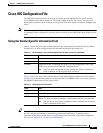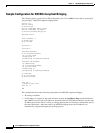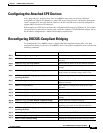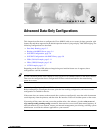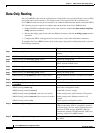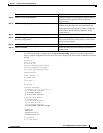
2-6
Cisco uBR924 Software Configuration Guide
OL-0337-05 (8/2002)
Chapter 2 DOCSIS-Bridging Configuration
Cisco IOS Software Image
Cisco IOS Software Image
The DOCSIS configuration file contains the filename for the software image that the
Cisco uBR924 router must be running. If this filename does not match the software image that is
currently installed on the router, the router must use the TFTP protocol to download the new image from
the server specified in the DOCSIS configuration file.
After the new software image has been downloaded, the Cisco uBR924 router resets itself and repeats
the entire power-on and provisioning process. This includes downloading the DOCSIS configuration file
again. However, because the software image is stored in non-volatile Flash memory, the router does not
have to download it again—the software download occurs only when the service provider specifies a new
software image filename in the DOCSIS configuration file.
If the Cisco uBR924 router cannot download the new image, it retries the download, up to a maximum
of 16 attempts. If the router still cannot download the image, it falls back to its previous software image
and attempts to go online with that image.
The service provider can also force the Cisco uBR924 router to download new software by putting a new
image filename in the DOCSIS configuration file and resetting the router. This should be done only after
warning the customer that the modem will be offline for a period of several minutes.
Note Because it can take several minutes for this download to be accomplished and for the
Cisco uBR924 router to repeat its power-on sequence, the desired software image can also be installed
on the router at the warehouse. In this case, the DOCSIS configuration files for each router should also
be updated with the proper filename.
Miscellaneous
Concatenation Support Specifies whether the cable modem supports DOCSIS 1.1 concatenation of upstream
packet requests.
Use RFC2104 HMAC-MD5 Specifies the algorithm used to compute the CMTS Message Integrity Check (MIC). If
yes, the HMAC-MD5 algorithm specified in RFC 2104 is used; otherwise, the algorithm
specified by RFC 1321 is used. (The algorithm used must match the one used on the
CMTS.)
Note Because the RFC 1321 algorithm can be reversed, Cisco strongly recommends the
use of only the more secure HMAC-MD5 algorithm.
CMTS Authentication Specifies an authentication string to be used between the provisioning server (which
creates the configuration files) and the CMTS. It allows the CMTS to authenticate the CM
provisioning with a central authentication service, such as a RADIUS server. This field is
typically used only for one-way cable modems that use telco-return.
1. The DOCSIS configuration file also contains fields for one-way cable modems that use telco-return, but these fields do not apply to the
Cisco uBR924 router, which is a two-way cable modem.
Table 2-2 DOCSIS Configuration File Parameters (continued)
Parameter
1
Description



